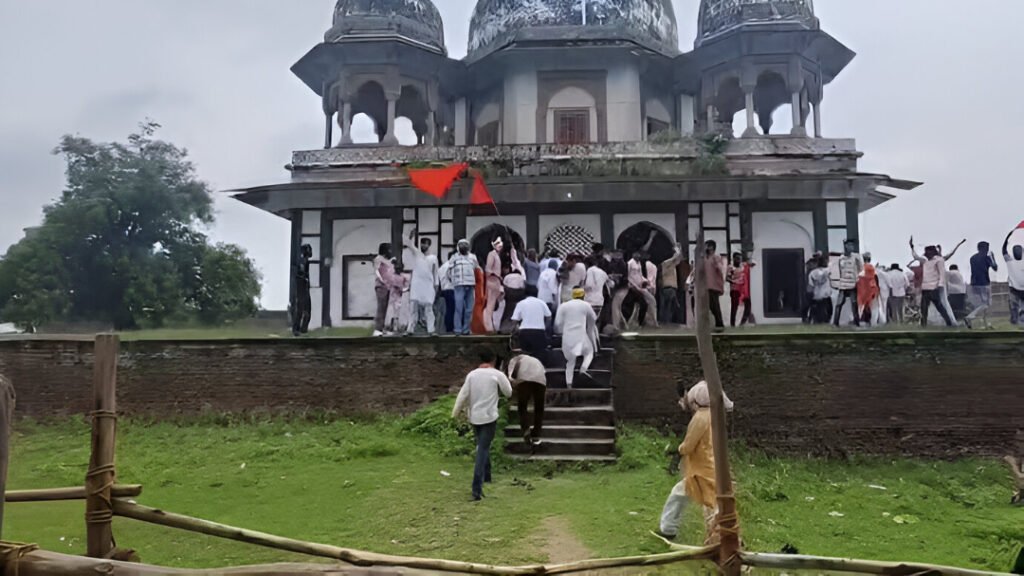
To provide a concise response, government documents record it as a tomb (Khasra 753) with the term “Maqbara Mangi” denoting national property.
The local as well as national media covering the clash at Fatehpur in August 2025 cite a spatial controversy in Abu Nagar (Abunagar) as being recorded under Khasra 753, with the tomb being called ‘Maqbara Mangi’ as noted in the national property documents. That wording, coupled with the khasra number, are the trademark details journalists provide when covering the disputes over the district’s land records.
The news reports as well as the government (and government) reports have been talking about the same things; the data is consistent.
It was reported in news outlets that, based on local revenue summaries coupled with interviews with the administration, the overarching detail is that the mausoleum in question is situated in district land records as a maqbara (mausoleum) and not a privately owned temple parcel associated with a khasra number in tehsil revenue maps. With the district administration referencing the core claim, there is quite a lot of agitation on the ground as police/administration briefings repeated that the site is recorded as a public or ‘national’ property. The literal scan is accessible on Bhulekh (land records) and is with the Fatehpur collectorate.
What transpired in situ, and what rendered the records pivotal?
On August 11, members of Hindu groups breached the Eidgah campus of Abu/Abunagar and proceeded to lift saffron flags on the tomb, claiming the structure is an ancient temple relic. Eyewitnesses to the event show clashing, and the police later on filed an FIR with some describable details of the site, which they filed as a tomb. As temple activists maintaining their narrative argued the site was and is historically a temple, media and community leaders looked up the revenue entry (khasra 753) to resolve the basic legal tussle: who, if anyone, and what does the title of the land and building call it? Hence, “Khasra 753—Maqbara Mangi” became the quote of citation.
Citing history vs. the present laws of land division—they are distinct but intertwined.
Covering the news independently, some branched out to investigate directly, which led to findings such as the colonial-era Fatehpur gazetteer, which mentioned the tomb of Nawab Abdus Samad Khan, which supports the long-claimed narrative that the mausoleum has existed. Serving as the primary leg to this narrative, it must be noted that such historians and gazetteers alongside archaeological records are usually separate for historians, with the current revenue classifications as separate for states referred to as up-to-date revenue registers. In the current issue, the entry in the revenue register has been crucial in the official documents.
Why the expression “maqbara Mangi/national property” holds legal significance
For any given piece of land, its description in revenue records as maqbara suggests it would not be treated as land for a house and, therefore, privately owned and freely transferable. It has public/municipal or revenue recognition. It does not, however, resolve archaeological disputes (is there an ancient temple underneath?) that have to be proven archaeologically and, if necessary, legally involving the archaeology department or the courts. But for immediate peace, order, and legal ownership issues, the khasra entry and the “national property” designation provide some practical help for the administration.
How a layperson or a researcher can self-verify the documents
- Take note of the tehsil/village as Abu/Abunagar, Sadar tehsil, and Fatehpur, and also the khasra number, which is 753.
- Go to the portal Uttar Pradesh Bhulekh or the Fatehpur district land records portal and search at the level of district→tehsil→village→khasra/gata for the RoR/khasra copy. These portals are upbhulekh.gov.in and the district website. According to the media reports, the Bhulekh entry matches the citations that were given.
What to Watch Next—Legal Traction and Verification
If parties insist on the historical-temple claim, expect one of the three pathways: (a) an administrative verification of revenue titles cited in the press; (b) an archaeological or heritage department inquiry regarding the inquiry of the historic layers; or (c) civil petitions to the courts declaring ownership or protection status. At the same time, the reliance on khasra entry by the administration continues to be the basis for enforcement and control order actions at the site.











